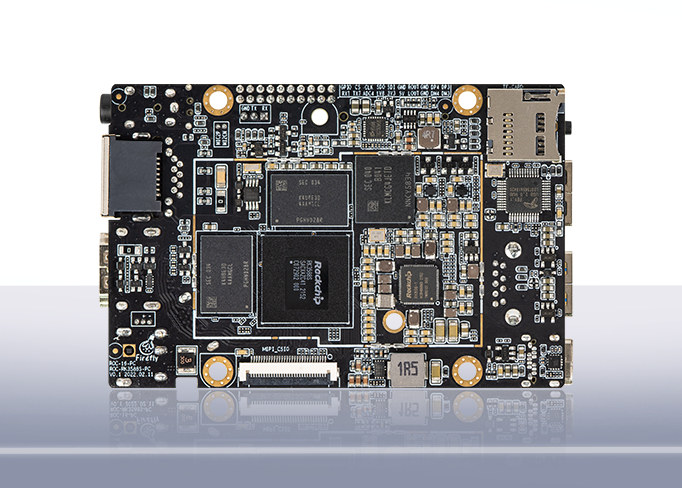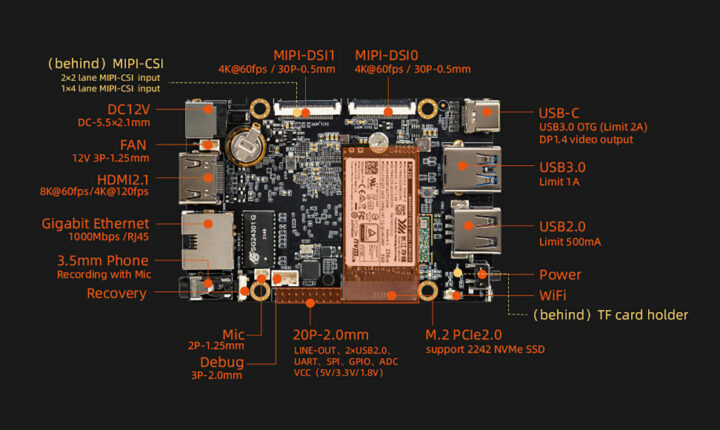Rockchip RK3588S processor, a cost-down version of Rockchip RK3588 SoC with fewer interfaces, has made its way into Firefly ROC-RK3588S-PC SBC (single board computer) about the size of a credit card and equipped with up to 32GB RAM.
The compact SBC also comes with up to 128GB eMMC flash, and offers support for NVMe storage, up to four video outputs through HDMI, USB-C and MIPI DSI interfaces, Gigabit Ethernet, USB 3.0, two MIPI CSI camera interfaces, and more.
Firefly ROC-RK3588S-PC specifications:
- SoC – Rockchip RK3588S octa-core processor with 4x Cortex-A76 cores @ up to 2.4 GHz, four Cortex-A55 cores, Arm Mali-G610 MP4 quad-core GPU with OpenGL ES3.2 / OpenCL 2.2 / Vulkan1.1 support, 6 TOPS NPU, and an 8Kp60 H.265/VP9/AVS2 video decoder, 4Kp60 decoder, 8Kp30 H.265/H.264 video encoder
- System Memory – 4GB, 8GB, 16GB or 32GB LPDDR4/LPDDR4x/LPDDR5
- Storage
- 16GB, 32GB, 64GB, or 128GB eMMC flash
- M.2 (PCIe 2.0) socket for M.2 2242 NVMe SSD
- MicroSD card slot
- Video Output
- HDMI 2.1 port up to 8Kp60 or 4Kp120
- DisplayPort 1.4 up to 8Kp30 via USB-C port
- 2x MIPI-DSI connectors up to 4Kp60
- Up to four independent video outputs
- Camera – 2x 2-lane MIPI-CSI input or 1x 4-lane MIPI-CSI input
- Audio
- 3.5mm audio (headphone+mic) jack
- Digital audio output via HDMI and DP ports
- Line OUT on header
- 2-pin header for microphone
- Networking
- Gigabit Ethernet RJ45 port
- Dual-band WiFi 5 and Bluetooth 4.2 BLE
- USB – 1x USB 3.0 Type-A port, 3x USB 2.0 interfaces (1x Type-A, 2x on header), 1x USB 3.0 OTG Type-C port with DP Alt mode
- Expansion
- M.2 (PCIe 2.0) socket for NVMe SSD
- 20-pin GPIO header, 2.0mm pitch, with LINE-OUT, 2x USB 2.0, UART, SPI, GPIO, ADC, VCC (5V/3.3V/1.8V)
- Misc – 12V fan 3-pin header, 3-pin debug header, Power and Recovery buttons
- Power Supply – 12V DC input via 5.5×2.1mm DC jack
- Power Consumption
- Idle: 0.42W (12V/35mA)
- Typical: 2.25W (12V/190mA)
- Max: 12W (12V/1000mA)
- Dimensions – 90 x 60mm
- Weight – Around 50g
- Temperature Range – Operating: -20°C to 60°C; storage: -20°C to 70°C
- Humidity – 40% to 70 %
Software support is the same as for its more expensive big brother, the ITX3358J mini-ITX motherboard, with Android 12.0, Ubuntu Desktop, Ubuntu Server, Debian 11, Buildroot, RTLinux, Kylin Linux, UOS, and others, thanks in part to UEFI boot support.
ROC-RK3588S-PC board should be particularly interesting to people wanting to leverage the higher performance of the Cortex-A76/A55 processor, Arm Mali-G610 GPU, and/or 6 TOPS AI accelerator without paying the premium asked for full-featured Rockchip RK3588 boards. It may not meet the requirements of people wanting high-speed NVMe storage since the RK3588S processor does without the 4-lane PCIe 3.0 found on RK3588, and instead, the board has to fall back to a PCIe 2.0/2.1 interface up to 5 Gbps.
The ROC-RK3588S-PC SBC sells for $219 with 4GB RAM and 32GB eMMC flash, and $299 for the 8GB/64GB combo. That’s quite more than I would have expected with the Rockchip RK3588-powered Rock5 Model B Pico-ITX SBC starting at $129 with 4GB RAM, and $149 with 8GB RAM. A few more details may be found on the product page.

Jean-Luc started CNX Software in 2010 as a part-time endeavor, before quitting his job as a software engineering manager, and starting to write daily news, and reviews full time later in 2011.
Support CNX Software! Donate via cryptocurrencies, become a Patron on Patreon, or purchase goods on Amazon or Aliexpress






